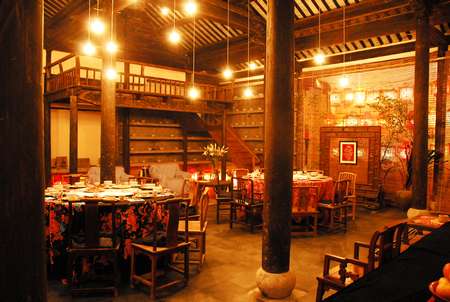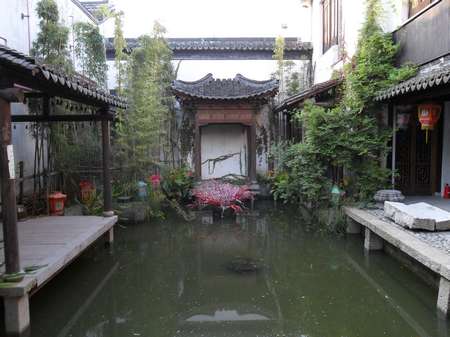A village for time traveling
|
|
|
A dining room in Si Min Hui Guan. Photo: Courtesy of Mathieu Borysevicz |
|
|
|
A courtyard at Si Min Hui Guan. Photo: Nick Muzyczka |
The village of Jinze town (in Qingpu district) is a patchwork of contemporary Chinese scenes. Here, small traditional houses, large-and small-scale agriculture, dusty farm roads, office blocks, factories and banks are jumbled together in a quiet and (relatively) leafy collage. Everywhere the landscape is bisected by waterways, with canals and ponds adding to the charm.
This is the location of a rather unusual project which aims to preserve traditional Chinese culture. The project is the brainchild of artist Hu Xiangcheng, who is also currently exhibiting his first major show in three years at the Shanghai Gallery of Art.
Hu has presided from scratch over the building of a traditional Chinese village on the site of an abandoned factory. Working with Hong Kong-born curator and art critic Johnson Chang and his brother Song-Yi Chang, Hu has designed and constructed a 3,793-square-meter Ming Dynasty (1368–1644) village whose very existence is intended to explore issues such as the disappearance of faith, traditional customs and spiritual belief systems in today's hypermodern world.
The center will be home to anthropological and historical studies, art exhibitions and concerts, with courses there conducted by universities. Thousands of years ago the area was home to the "Liangzhu Culture," the last "Neolithic Jade" culture in the Yangtze River Delta region. Historical construction methods have also been explored through the building of the village, a process which involved re-creating folk traditions.
"Hu is very much focused on rituals," said Mathieu Borysevicz, the deputy director of the Shanghai Gallery of Art. "Even when they were building the buildings, they had rituals for everything, including breaking the earth and placing the first stones." Most of the construction workers for the project came from the local area and the process involved a lot of information sharing.
Si Min Hui Guan (the name of the village) has been developed in collaboration with Tongji University's Architectural Department, the Shanghai Theater Academy, the China Academy of Art and many other institutions.
The funding for the project comes from private sources and there are plans to cover some of the costs by using one of the buildings as a production center for crafts. The village is set up in such a way as to be amenable for concerts and renting rooms for accommodation and parties. Hu was very keen to point out, however, that this is a not-for-profit venture whose primary intention is to help reinvigorate village life and protect links with the past.
While the setup of the village could potentially facilitate a more commercial project, there is evidence that the developers see this more as a purely cultural preservation. Upriver they have bought an area of farmland that is being allowed to organically cleanse itself after years of incessant fertilizer use. As well, Hu has been making deals with residents in Jinze - many of whom are older people whose younger relatives have moved into the city and now occupy house that are too big for them - to protect their homes from demolition.
Si Min Hui Guan is certainly pretty, with fine-looking buildings that have obviously been fashioned with care and consideration. The interior decoration is equally splendid, with a wealth of antique furniture, wedding chambers, dining rooms and even a concert hall.
Hu's artistic temperament can be seen in nuanced ways around the village. Buildings by the side of the river are constructed in way that follows the curve of the bank, while outdoor decking (all made from reclaimed wood) has been cleverly cut into wavy lines not straight planks.
 0
0 









Go to Forum >>0 Comments